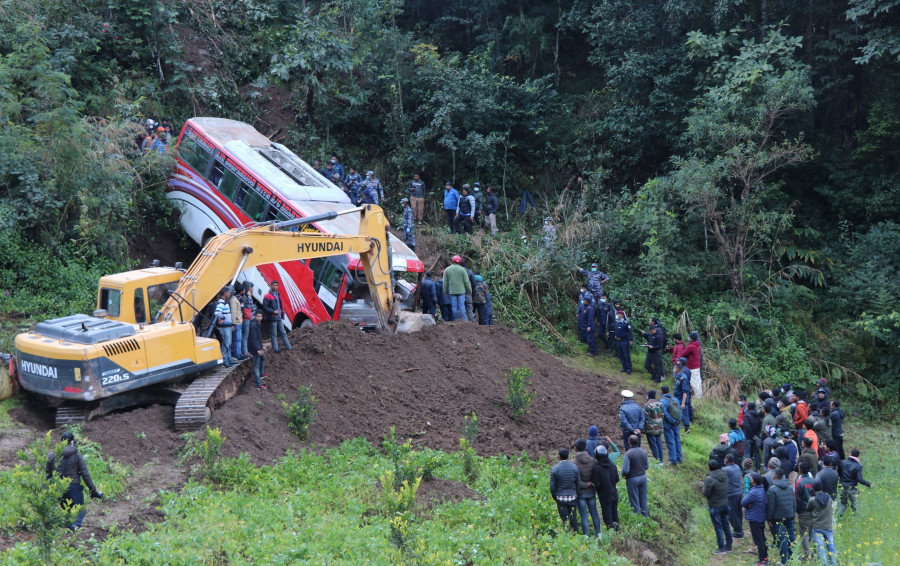
Road traffic-related injuries and fatalities can be reduced by bringing changes to the road environment, reducing speed and traffic volume, and separating motorised vehicles from pedestrians and non-motorised vehicles. However, Nepal’s current efforts are inadequate to lower traffic-related fatalities or injuries in the foreseeable future. The country’s current state of road safety is not a result of a lack of laws and regulations but insufficient arrangements for the administration and implementation of existing provisions.
Even the simplest of road safety measures can have a huge impact. These include maintaining lane discipline on urban roads, keeping the speed limit below 30km/h in residential areas, schools or hospitals, and keeping vehicle-free zones around places where people go for leisure or shopping. Other obvious measures could be clearly marked roads, visible road signs, road lights, and pedestrian-only footpaths. The failure to honour these basic rules means that we have to be worried about our lives each time we are on the road.
The Global Status Report on Road Safety (2018) revealed the stagnated progress in many low- and middle-income countries. The performance of the first decade of actions for road safety (2011-2020) was not satisfactory. This was also evident from the Sustainable Development Goals target 3.6 to halve the number of global deaths and injuries from road traffic accidents. Meanwhile, the global road safety community was working behind the scenes to motivate the leaders in these countries by highlighting the success stories of some high-income countries.
The World Health Organisation (WHO) is leading the United Nations Road Safety Collaboration (UNRSC) and developing several reports and guiding documents. The 12 voluntary global targets (with 34 indicators) for road safety are among those important outputs. These global performance targets were developed in 2016-17 through a process involving all WHO member states and key stakeholders. The objective of the targets was to set goals related to key risk factors and service delivery mechanisms to reduce road traffic casualties. A consensus was reached in a meeting of WHO Member States held from 20 to 21 November 2017 in Geneva.
The first of the 12 voluntary targets for road safety directs nations to establish a comprehensive multi-sectoral national road safety action plan with time-bound targets by 2020, and Nepal is already two years behind. There is no lead agency for road safety, laws governing road safety, or national road safety action plan with time-bound targets in Nepal. This setback will impede the remaining 11 targets, which are intended to be achieved by 2030 and are related to global alignment, new roads, existing roads, vehicle standards, speeding, motorcycle helmets, vehicle occupant protection, driving under the influence, distraction by mobile phone, professional drivers, and timely emergency care.
The Global Plan for the Decade of Action for Road Safety 2021-2030 was launched a year ago by the leadership of the World Health Organisation to guide nations to develop and implement activities to achieve the above-mentioned voluntary targets. The Global Plan "rejects business as usual and calls on governments and stakeholders to take a new path—one that prioritises and implements an integrated safe system approach that squarely positions road safety as a key driver of sustainable development. It also calls for actions that help the world hit the target of a 50 percent reduction in the number of road traffic deaths and serious injuries by 2030." Because road safety is a shared responsibility, the Global Plan inspires all stakeholders, including civil society, academia, the private sector, donors, community and youth leaders, among others. Part III of the action plan describes the “requirements” for its successful implementation and Part IV details the roles of government, academia and other stakeholders.
Recently, the international community has reiterated commitments to improving the road safety situation through a high-level meeting in July 2022 under the theme of “The 2030 horizon for road safety: Securing a decade of action and delivery.” Sadly, a matching degree of political commitment to road safety is not yet made by Nepal. This might be because the ministers of the responsible ministries are not well informed about it. The Ministry of Health and Population, which is also the WHO's focal ministry for road traffic injury prevention, has experienced frequent changes in leadership over the past five years. The other lead agency, the Ministry of Physical Infrastructure and Transport, largely focussed on road construction, and the sub-ordinate Department of Transport Management has not realised the responsibilities delegated to it by existing legislation.
Nepali bureaucracy often does not work beyond its comfort zone, is defensive, does not come up with creative ideas, is reluctant to keep informed with related current affairs, and doesn’t attempt to educate the political leadership. Nepal has yet to accede to any of the core road safety-related UN legal instruments that are instrumental in harmonising national efforts with global road safety standards. Most often, concerned people and the media call for actions that eliminate road traffic accidents, injuries, and fatalities. There is no magic bullet that will make our roads safer. Road safety is a shared responsibility. Responsible agencies and authorities must be aware of the 12 voluntary targets for road safety and plan in accordance with the recommendations of the global plan. After all, business as usual will not make any difference, and the loss of lives on our roads will continue.












